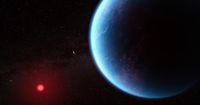On April 17, 2025, scientists announced a groundbreaking discovery that could change our understanding of life beyond Earth. Researchers have detected gases in the atmosphere of the exoplanet K2-18b, located 124 light-years away, which are exclusively produced by biological processes on Earth. These gases, dimethylsulfide (DMS) and dimethyldisulfide (DMDS), suggest the possibility of microbial life existing on K2-18b, potentially resembling the vibrant ecosystems found in Earth's oceans.
The findings were made using the James Webb Space Telescope, a state-of-the-art observatory that has been pivotal in recent astronomical discoveries. Astrophysicist Nikku Madhusudhan from the University of Cambridge, who led the research, emphasized the significance of this discovery, stating, "This is a turning point in the search for life outside the solar system. We have shown that it is possible to detect biosignatures on potentially habitable planets with current technology."
K2-18b is particularly interesting because it lies within the so-called habitable zone of its star, K2-18, a red dwarf that is smaller and less bright than our Sun. This positioning raises the possibility of liquid water existing on the planet, a crucial element for life as we know it. In fact, in 2019, researchers had already detected water vapor in the atmosphere of K2-18b, and in 2023, they identified methane and carbon dioxide.
Despite the excitement surrounding these findings, researchers caution that the evidence for extraterrestrial life is still indirect. "We have not yet found direct evidence of life," Madhusudhan explained. The gases detected are produced by microorganisms, primarily algae, on Earth, leading scientists to speculate that K2-18b may host similar life forms.
However, not all experts are convinced by the claims. Ignas Snellen, an exoplanet researcher at Leiden University, expressed skepticism, labeling the assertions as "irresponsible nonsense." He argued that the research team cannot definitively prove their claims and are merely observing a blip in a signal that could represent something entirely different. Snellen warned that sensationalizing preliminary findings could ultimately undermine the credibility of future research in the field.
"I don't know whether to laugh or cry," Snellen remarked, highlighting the delicate balance scientists must maintain in communicating their findings. "It's essential to generate enthusiasm for this field of research, but we must also ensure that we don't damage our credibility when serious evidence does emerge."">
The debate continues over the implications of these findings. While the detection of DMS and DMDS is indeed exciting, researchers emphasize the need for further observations to confirm the presence of life on K2-18b. The scientific community remains divided, with some urging caution and others advocating for further exploration.
As the search for extraterrestrial life progresses, the discovery of potential biosignatures on K2-18b represents a significant milestone. It highlights the capabilities of modern technology, such as the James Webb Space Telescope, in uncovering the mysteries of the universe. The excitement surrounding this discovery is palpable, but it also serves as a reminder of the careful approach required in scientific inquiry.
In conclusion, the findings regarding K2-18b are a testament to human curiosity and our relentless pursuit of knowledge about the cosmos. As scientists continue to explore the universe, the potential for discovering life beyond Earth becomes ever more tantalizing. The journey is far from over, and each new discovery brings us one step closer to answering the age-old question: Are we alone in the universe?




